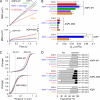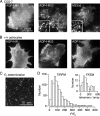Aquaporin-4 dynamics in orthogonal arrays in live cells visualized by quantum dot single particle tracking
- PMID: 18495865
- PMCID: PMC2488293
- DOI: 10.1091/mbc.e08-03-0322
Aquaporin-4 dynamics in orthogonal arrays in live cells visualized by quantum dot single particle tracking
Abstract
Freeze-fracture electron microscopy (FFEM) indicates that aquaporin-4 (AQP4) water channels can assemble in cell plasma membranes in orthogonal arrays of particles (OAPs). We investigated the determinants and dynamics of AQP4 assembly in OAPs by tracking single AQP4 molecules labeled with quantum dots at an engineered external epitope. In several transfected cell types, including primary astrocyte cultures, the long N-terminal "M1" form of AQP4 diffused freely, with diffusion coefficient approximately 5 x 10(-10) cm(2)/s, covering approximately 5 microm in 5 min. The short N-terminal "M23" form of AQP4, which by FFEM was found to form OAPs, was relatively immobile, moving only approximately 0.4 microm in 5 min. Actin modulation by latrunculin or jasplakinolide did not affect AQP4-M23 diffusion, but deletion of its C-terminal postsynaptic density 95/disc-large/zona occludens (PDZ) binding domain increased its range by approximately twofold over minutes. Biophysical analysis of short-range AQP4-M23 diffusion within OAPs indicated a spring-like potential, with a restoring force of approximately 6.5 pN/microm. These and additional experiments indicated that 1) AQP4-M1 and AQP4-M23 isoforms do not coassociate in OAPs; 2) OAPs can be imaged directly by total internal reflection fluorescence microscopy; and 3) OAPs are relatively fixed, noninterconvertible assemblies that do not require cytoskeletal or PDZ-mediated interactions for formation. Our measurements are the first to visualize OAPs in live cells.
Figures






References
-
- Amiry-Moghaddam M., Frydenlund D. S., Ottersen O. P. Anchoring of aquaporin-4 in brain: molecular mechanisms and implications for the physiology and pathophysiology of water transport. Neuroscience. 2004;129:999–1010. - PubMed
-
- Frigeri A., Gropper M. A., Umenishi F., Kawashima M., Brown D., Verkman A. S. Localization of MIWC and GLIP water channel homologs in neuromuscular, epithelial and glandular tissues. J. Cell Sci. 1995;108:2993–3002. - PubMed
Publication types
MeSH terms
Substances
Grants and funding
- R01 EY013574/EY/NEI NIH HHS/United States
- GM-808512/GM/NIGMS NIH HHS/United States
- R01 EB000415/EB/NIBIB NIH HHS/United States
- R01 DK035124/DK/NIDDK NIH HHS/United States
- EB-00415/EB/NIBIB NIH HHS/United States
- R01 HL059198/HL/NHLBI NIH HHS/United States
- HL-73856/HL/NHLBI NIH HHS/United States
- DK-35124/DK/NIDDK NIH HHS/United States
- EY-13574/EY/NEI NIH HHS/United States
- DK-72517/DK/NIDDK NIH HHS/United States
- R01 HL073856/HL/NHLBI NIH HHS/United States
- P30 DK072517/DK/NIDDK NIH HHS/United States
- HL-59198/HL/NHLBI NIH HHS/United States
- R37 DK035124/DK/NIDDK NIH HHS/United States
- R37 EB000415/EB/NIBIB NIH HHS/United States
LinkOut - more resources
Full Text Sources
Other Literature Sources

